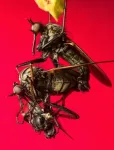(Press-News.org) Citrus fruit rind color has long been used as an indicator of ripeness, but for some fruits such as mandarin fruit in the Chongqing region of China, the peel and flesh do not ripen synchronously, with the flesh usually reaching maturity while the peel is still green. This is a characteristic that seriously affects its commercial value. In new research published in the Journal of the Science of Food and Agriculture, investigators have discovered how red and blue LED light can stimulate color change in mandarin fruit.
Experiments showed that this light exposure causes fruit color change by promoting chlorophyll degradation and carotenoid synthesis. A protein called CcUNE10, which is part of the bHLH transcription factor family, played an important role by binding to and activating certain genes involved in chlorophyll degradation.
“The above results provide a theoretical basis for the further study of the postharvest coloration of mandarin fruit and enhance research on the bHLH transcription factor family's function,” the authors wrote.
URL upon publication: https://onlinelibrary.wiley.com/doi/10.1002/jsfa.14119
Additional Information
NOTE: The information contained in this release is protected by copyright. Please include journal attribution in all coverage. For more information or to obtain a PDF of any study, please contact: Sara Henning-Stout, newsroom@wiley.com.
About the Journal
The Journal of the Science of Food and Agriculture publishes peer-reviewed original research, reviews, mini-reviews, perspectives and spotlights in these areas, with particular emphasis on interdisciplinary studies at the agriculture/ food interface.
About Wiley
Wiley is one of the world’s largest publishers and a trusted leader in research and learning. Our industry-leading content, services, platforms, and knowledge networks are tailored to meet the evolving needs of our customers and partners, including researchers, students, instructors, professionals, institutions, and corporations. We empower knowledge-seekers to transform today’s biggest obstacles into tomorrow’s brightest opportunities. For more than two centuries, Wiley has been delivering on its timeless mission to unlock human potential. Visit us at Wiley.com. Follow us on Facebook, X, LinkedIn and Instagram.
END
How does light affect citrus fruit coloration and the timing of peel and flesh ripening?
2025-02-05
ELSE PRESS RELEASES FROM THIS DATE:
Male flies sharpened their eyesight to call the females' bluff
2025-02-05
With bloated bellies and hairy legs, female flies try to look bigger to get food from courting mates. But male flies, in turn, have sharpened their eyesight to call their bluff. A new study by researchers from the Universities of Gothenburg and Stockholm suggests that this is an ongoing evolution where both sexes try to outsmart each other.
For the first time, researchers have been able to show that also males can develop traits that help them pass on their genes despite the manipulative adaptations of the opposite sex. In different species of dance flies, there is a clear correlation between how richly decorated the female ...
School bans alone not enough to tackle negative impacts of phone and social media use
2025-02-05
Students attending schools that ban the use of phones throughout the school day aren’t necessarily experiencing better mental health and wellbeing, as the first worldwide study of its kind has found that just banning smartphones is not enough to tackle their negative impacts.
In a landmark study published today (Wednesday 5 Feb) in Lancet Regional Health Europe, 1227 students from 30 schools across England provided data about smartphone and social media usage and a range of mental health, wellbeing and other outcomes. ...
Explaining science in court with comics
2025-02-05
Imagine being summoned as a juror in a murder trial. The expert responsible for analyzing DNA traces at the crime scene has just explained that they match the defendant’s profile. “Then the culprit must be them,” you think. At this point, however, the expert adds: “The sample, however, is partially degraded.” What does this mean? How does this information affect your judgment? The scientist further explains that there is a one-in-a-billion probability that other people could match the identified genetic profile. ...
‘Living’ electrodes breathe new life into traditional silicon electronics
2025-02-05
Osaka, Japan – High-speed electronic devices that do not use much power are useful for wireless communication. High-speed operation has traditionally been achieved by making devices smaller, but as devices become smaller, fabrication becomes increasingly difficult. Have we reached a dead end?
Not yet! A research team at Osaka University is exploring another way to improve device performance: placing a patterned metal layer, i.e., a structural metamaterial, on top of a traditional substrate, e.g., silicon, to accelerate ...
One in four chance per year that rocket junk will enter busy airspace
2025-02-05
There’s a 26 per cent annual chance that space rocket junk will re-enter the atmosphere and pass through a busy flight area, according to a recent UBC study.
While the chance of debris hitting an aircraft is very low, the research highlights that the potential for uncontrolled space rocket junk to disrupt flights and create additional costs for airlines and passengers is not.
Space junk disrupting air traffic is far from unheard of. In 2022, a re-entering 20-tonne piece of rocket prompted Spanish and French aviation authorities to close parts ...
Later-onset menopause linked to healthier blood vessels, lower heart disease risk
2025-02-05
Women who go through menopause later in life have healthier blood vessels for years to come than those who go through it earlier, according to new University of Colorado Boulder research.
The study, published in the American Heart Association journal Circulation Research, offers new insight into why females who stop menstruating at age 55 or later are significantly less likely to have heart attacks and strokes in their postmenopausal years.
Arriving just in time for Women's Heart Health Month, in February, the findings could help lead to new therapies, including dietary interventions, to reduce risk of heart ...
New study reveals how RNA travels between cells to control genes across generations
2025-02-05
RNA-based medicines are one of the most promising ways to fight human disease, as demonstrated by the recent successes of RNA vaccines and double-stranded RNA (dsRNA) therapies. But while health care providers can now successfully develop drugs that use dsRNA to accurately target and silence disease-causing genes, a major challenge remains: getting these potentially life-saving RNA molecules into cells efficiently.
A new study published in the journal eLife on February 4, 2025, may lead to breakthroughs in RNA-based drug development. University of Maryland researchers used microscopic roundworms ...
Women health sector leaders good for a nation’s wealth, health, innovation, ethics
2025-02-05
Women health sector leaders are good for a nation’s wealth, health, innovation, and ethics, among other things, finds a review of the available evidence, published in the open access journal BMJ Global Health.
Yet despite their unique and positive impact, they are a major underused resource, particularly in low and middle income countries, say the researchers, who call for more and sustained investment to maximise women’s potential and reap the benefits of their contribution.
Despite making up 70% of the healthcare workforce, as a whole, and 90% of the nursing ...
‘Good’ cholesterol may be linked to heightened glaucoma risk among over 55s
2025-02-05
‘Good’ (HDL) cholesterol, usually considered to be beneficial for health, may be linked to a heightened risk of the serious eye condition, glaucoma—at least among the over 55s— suggest the results of a large observational study, published online in the British Journal of Ophthalmology.
Paradoxically, ‘bad’ (LDL) cholesterol, usually regarded as harmful to health, may be associated with a lower risk of glaucoma, a condition that damages the optic nerve, potentially leading to irreversible sight ...
GLP-1 drug shows little benefit for people with Parkinson’s disease
2025-02-05
The GLP-1 drug, exenatide, has no positive impact on the movement, symptoms or brain imaging of people with Parkinson’s, finds a new study led by UCL researchers.
The world’s largest and longest trial of exenatide in people with Parkinson’s disease was funded by the National Institute for Health & Care Research (NIHR) with support for sub-studies from Cure Parkinson’s and Van Andel Institute.
For their research, published in The Lancet, the team designed a randomised controlled phase 3 trial to definitively determine whether exenatide use was associated with any benefit in people with Parkinson’s and ...



